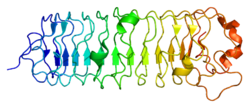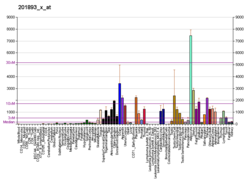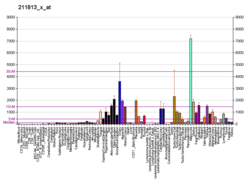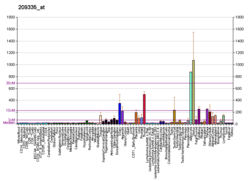Decorin
| DCN | |||||||||||||||||||||||||||||||||||||||||||||||||||
|---|---|---|---|---|---|---|---|---|---|---|---|---|---|---|---|---|---|---|---|---|---|---|---|---|---|---|---|---|---|---|---|---|---|---|---|---|---|---|---|---|---|---|---|---|---|---|---|---|---|---|---|
 | |||||||||||||||||||||||||||||||||||||||||||||||||||
| Identifiers | |||||||||||||||||||||||||||||||||||||||||||||||||||
| Aliases | DCN, Dcn, DC, DSPG2, PG40, PGII, PGS2, SLRR1B, mDcn, CSCD, decorin | ||||||||||||||||||||||||||||||||||||||||||||||||||
| External IDs | OMIM: 125255 MGI: 94872 HomoloGene: 22430 GeneCards: DCN | ||||||||||||||||||||||||||||||||||||||||||||||||||
| |||||||||||||||||||||||||||||||||||||||||||||||||||
| |||||||||||||||||||||||||||||||||||||||||||||||||||
| |||||||||||||||||||||||||||||||||||||||||||||||||||
| |||||||||||||||||||||||||||||||||||||||||||||||||||
| |||||||||||||||||||||||||||||||||||||||||||||||||||
| Wikidata | |||||||||||||||||||||||||||||||||||||||||||||||||||
| |||||||||||||||||||||||||||||||||||||||||||||||||||
Decorin is a protein that in humans is encoded by the DCN gene.
Decorin is a proteoglycan that is on average 90 - 140 kilodaltons (kDa) in molecular weight. It belongs to the small leucine-rich proteoglycan (SLRP) family and consists of a protein core containing leucine repeats with a glycosaminoglycan (GAG) chain consisting of either chondroitin sulfate (CS) or dermatan sulfate (DS).
Decorin is a small cellular or pericellular matrix proteoglycan and is closely related in structure to biglycan protein. Decorin and biglycan are thought to be the result of a gene duplication. This protein is a component of connective tissue, binds to type I collagen fibrils, and plays a role in matrix assembly.[5]
Naming
Decorin's name is a derivative of both the fact that it "decorates" collagen type I, and that it interacts with the "d" and "e" bands of fibrils of this collagen.
Function
Decorin appears to influence fibrillogenesis, and also interacts with fibronectin, thrombospondin, the complement component C1q, epidermal growth factor receptor (EGFR) and transforming growth factor-beta (TGF-beta).
Decorin has been shown to either enhance or inhibit the activity of TGF-beta 1. The primary function of decorin involves regulation during the cell cycle.
It has been involved in the regulation of autophagy, of endothelial cell and inhibits angiogenesis. This process is mediated by a high-affinity interaction with VEGFR2 (vascular endothelial growth factor receptor) which leads to increased levels of tumor suppressor gene called PEG3.[6] Other angiogenic growth factors that decorin inhibits are angiopoietin, hepatocyte growth factor (HGF) and platelet-derived growth factor (PDGF).[7]
Decorin has recently been established as a myokine. In this role, it promotes muscle hypertrophy by binding with myostatin.[8]
Clinical significance
Keloid scars have decreased decorin expression compared to healthy skin.[9] Development of congenital stromal corneal dystrophy is dependent on export and extracellular deposition of truncated decorin. [10]
Animal studies
Infusion of decorin into experimental rodent spinal cord injuries has been shown to suppress scar formation and promote axon growth.
Decorin has been shown to have anti-tumorigenic properties in an experimental murine tumor model and is capable of suppressing the growth of various tumor cell lines. [11] The decorin-deficient knockout mouse shows reduced inflammatory reactions during contact dermatitis due to a defect in leukocyte recruitment and altered interferon gamma function. [12] [13]
Interactions
Decorin has been shown to interact with:
- Collagen type I[14]
- Epidermal growth factor receptor[15][16] and
- TGF beta 1,[14][17][18]
- TLR2,[19] and
- TLR4.[19]
References
- ^ a b c GRCh38: Ensembl release 89: ENSG00000011465 – Ensembl, May 2017
- ^ a b c GRCm38: Ensembl release 89: ENSMUSG00000019929 – Ensembl, May 2017
- ^ "Human PubMed Reference:". National Center for Biotechnology Information, U.S. National Library of Medicine.
- ^ "Mouse PubMed Reference:". National Center for Biotechnology Information, U.S. National Library of Medicine.
- ^ "Entrez Gene: DCN decorin".
- ^ Buraschi S, Neill T, Goyal A, Poluzzi C, Smythies J, Owens RT, et al. (July 2013). "Decorin causes autophagy in endothelial cells via Peg3". Proceedings of the National Academy of Sciences of the United States of America. 110 (28): E2582-91. Bibcode:2013PNAS..110E2582B. doi:10.1073/pnas.1305732110. PMC 3710796. PMID 23798385.
- ^ Järveläinen H, Sainio A, Wight TN (April 2015). "Pivotal role for decorin in angiogenesis". Matrix Biology. 43: 15–26. doi:10.1016/j.matbio.2015.01.023. PMC 4560244. PMID 25661523.
- ^ Kanzleiter T, Rath M, Görgens SW, Jensen J, Tangen DS, Kolnes AJ, et al. (July 2014). "The myokine decorin is regulated by contraction and involved in muscle hypertrophy". Biochemical and Biophysical Research Communications. 450 (2): 1089–94. doi:10.1016/j.bbrc.2014.06.123. PMID 24996176.
- ^ Jumper N, Paus R, Bayat A (September 2015). "Functional histopathology of keloid disease". Histology and Histopathology. 30 (9): 1033–57. doi:10.14670/HH-11-624. PMID 25900252.
- ^ Mellgren AE, Bruland O, Vedeler A, Saraste J, Schönheit J, Bredrup C, et al. (May 2015). "Development of congenital stromal corneal dystrophy is dependent on export and extracellular deposition of truncated decorin". Investigative Ophthalmology & Visual Science. 56 (5): 2909–15. doi:10.1167/iovs.14-16014. PMID 26029887.
- ^ Sofeu Feugaing DD, Götte M, Viola M (January 2013). "More than matrix: the multifaceted role of decorin in cancer". European Journal of Cell Biology. 92 (1): 1–11. doi:10.1016/j.ejcb.2012.08.004. PMID 23058688.
- ^ Seidler DG, Mohamed NA, Bocian C, Stadtmann A, Hermann S, Schäfers K, et al. (December 2011). "The role for decorin in delayed-type hypersensitivity". Journal of Immunology. 187 (11): 6108–19. doi:10.4049/jimmunol.1100373. PMC 5070385. PMID 22043007.
- ^ Bocian C, Urbanowitz AK, Owens RT, Iozzo RV, Götte M, Seidler DG (May 2013). "Decorin potentiates interferon-γ activity in a model of allergic inflammation". The Journal of Biological Chemistry. 288 (18): 12699–711. doi:10.1074/jbc.M112.419366. PMC 3642316. PMID 23460644.
- ^ a b Schönherr E, Broszat M, Brandan E, Bruckner P, Kresse H (July 1998). "Decorin core protein fragment Leu155-Val260 interacts with TGF-beta but does not compete for decorin binding to type I collagen". Archives of Biochemistry and Biophysics. 355 (2): 241–8. doi:10.1006/abbi.1998.0720. PMID 9675033.
- ^ Santra M, Reed CC, Iozzo RV (September 2002). "Decorin binds to a narrow region of the epidermal growth factor (EGF) receptor, partially overlapping but distinct from the EGF-binding epitope". The Journal of Biological Chemistry. 277 (38): 35671–81. doi:10.1074/jbc.M205317200. PMID 12105206. S2CID 20575381.
- ^ Iozzo RV, Moscatello DK, McQuillan DJ, Eichstetter I (February 1999). "Decorin is a biological ligand for the epidermal growth factor receptor". The Journal of Biological Chemistry. 274 (8): 4489–92. doi:10.1074/jbc.274.8.4489. PMID 9988678. S2CID 32175802.
- ^ Hildebrand A, Romarís M, Rasmussen LM, Heinegård D, Twardzik DR, Border WA, Ruoslahti E (September 1994). "Interaction of the small interstitial proteoglycans biglycan, decorin and fibromodulin with transforming growth factor beta". The Biochemical Journal. 302 ( Pt 2) (2): 527–34. doi:10.1042/bj3020527. PMC 1137259. PMID 8093006.
- ^ Takeuchi Y, Kodama Y, Matsumoto T (December 1994). "Bone matrix decorin binds transforming growth factor-beta and enhances its bioactivity". The Journal of Biological Chemistry. 269 (51): 32634–8. doi:10.1016/S0021-9258(18)31681-8. PMID 7798269.
- ^ a b Merline R, Moreth K, Beckmann J, Nastase MV, Zeng-Brouwers J, Tralhão JG, et al. (November 2011). "Signaling by the matrix proteoglycan decorin controls inflammation and cancer through PDCD4 and MicroRNA-21". Science Signaling. 4 (199): ra75. doi:10.1126/scisignal.2001868. PMC 5029092. PMID 22087031.
Further reading
- Ständer M, Naumann U, Wick W, Weller M (May 1999). "Transforming growth factor-beta and p-21: multiple molecular targets of decorin-mediated suppression of neoplastic growth". Cell and Tissue Research. 296 (2): 221–7. doi:10.1007/s004410051283. PMID 10382266. S2CID 20282995.
- Fujisawa R (March 2002). "[Recent advances in research on bone matrix proteins]". Nihon Rinsho. Japanese Journal of Clinical Medicine. 60 (Suppl 3): 72–8. PMID 11979972.
- Krumdieck R, Höök M, Rosenberg LC, Volanakis JE (December 1992). "The proteoglycan decorin binds C1q and inhibits the activity of the C1 complex". Journal of Immunology. 149 (11): 3695–701. doi:10.4049/jimmunol.149.11.3695. PMID 1431141. S2CID 23005992.
- Winnemöller M, Schön P, Vischer P, Kresse H (October 1992). "Interactions between thrombospondin and the small proteoglycan decorin: interference with cell attachment". European Journal of Cell Biology. 59 (1): 47–55. PMID 1468447.
- Murphy-Ullrich JE, Schultz-Cherry S, Höök M (February 1992). "Transforming growth factor-beta complexes with thrombospondin". Molecular Biology of the Cell. 3 (2): 181–8. doi:10.1091/mbc.3.2.181. PMC 275517. PMID 1550960.
- Pulkkinen L, Alitalo T, Krusius T, Peltonen L (1992). "Expression of decorin in human tissues and cell lines and defined chromosomal assignment of the gene locus (DCN)". Cytogenetics and Cell Genetics. 60 (2): 107–11. doi:10.1159/000133314. PMID 1611907.
- McBride OW, Fisher LW, Young MF (February 1990). "Localization of PGI (biglycan, BGN) and PGII (decorin, DCN, PG-40) genes on human chromosomes Xq13-qter and 12q, respectively". Genomics. 6 (2): 219–25. doi:10.1016/0888-7543(90)90560-H. PMID 1968422.
- Fleischmajer R, Fisher LW, MacDonald ED, Jacobs L, Perlish JS, Termine JD (February 1991). "Decorin interacts with fibrillar collagen of embryonic and adult human skin". Journal of Structural Biology. 106 (1): 82–90. doi:10.1016/1047-8477(91)90065-5. PMID 2059554.
- Pulkkinen L, Kainulainen K, Krusius T, Mäkinen P, Schollin J, Gustavsson KH, Peltonen L (October 1990). "Deficient expression of the gene coding for decorin in a lethal form of Marfan syndrome". The Journal of Biological Chemistry. 265 (29): 17780–5. doi:10.1016/S0021-9258(18)38231-0. PMID 2211661.
- Yamaguchi Y, Mann DM, Ruoslahti E (July 1990). "Negative regulation of transforming growth factor-beta by the proteoglycan decorin". Nature. 346 (6281): 281–4. Bibcode:1990Natur.346..281Y. doi:10.1038/346281a0. PMID 2374594. S2CID 4272333.
- Greve H, Blumberg P, Schmidt G, Schlumberger W, Rauterberg J, Kresse H (July 1990). "Influence of collagen lattice on the metabolism of small proteoglycan II by cultured fibroblasts". The Biochemical Journal. 269 (1): 149–55. doi:10.1042/bj2690149. PMC 1131544. PMID 2375748.
- Roughley PJ, White RJ (September 1989). "Dermatan sulphate proteoglycans of human articular cartilage. The properties of dermatan sulphate proteoglycans I and II". The Biochemical Journal. 262 (3): 823–7. doi:10.1042/bj2620823. PMC 1133347. PMID 2590169.
- Fisher LW, Termine JD, Young MF (March 1989). "Deduced protein sequence of bone small proteoglycan I (biglycan) shows homology with proteoglycan II (decorin) and several nonconnective tissue proteins in a variety of species". The Journal of Biological Chemistry. 264 (8): 4571–6. doi:10.1016/S0021-9258(18)83781-4. PMID 2647739.
- Yamaguchi Y, Ruoslahti E (November 1988). "Expression of human proteoglycan in Chinese hamster ovary cells inhibits cell proliferation". Nature. 336 (6196): 244–6. Bibcode:1988Natur.336..244Y. doi:10.1038/336244a0. PMID 3194009. S2CID 4338095.
- Krusius T, Ruoslahti E (October 1986). "Primary structure of an extracellular matrix proteoglycan core protein deduced from cloned cDNA". Proceedings of the National Academy of Sciences of the United States of America. 83 (20): 7683–7. Bibcode:1986PNAS...83.7683K. doi:10.1073/pnas.83.20.7683. PMC 386785. PMID 3484330.
- Fisher LW, Hawkins GR, Tuross N, Termine JD (July 1987). "Purification and partial characterization of small proteoglycans I and II, bone sialoproteins I and II, and osteonectin from the mineral compartment of developing human bone". The Journal of Biological Chemistry. 262 (20): 9702–8. doi:10.1016/S0021-9258(18)47991-4. PMID 3597437.
- Lysiak JJ, Hunt J, Pringle GA, Lala PK (April 1995). "Localization of transforming growth factor beta and its natural inhibitor decorin in the human placenta and decidua throughout gestation". Placenta. 16 (3): 221–31. doi:10.1016/0143-4004(95)90110-8. PMID 7638106.
- Takeuchi Y, Kodama Y, Matsumoto T (December 1994). "Bone matrix decorin binds transforming growth factor-beta and enhances its bioactivity". The Journal of Biological Chemistry. 269 (51): 32634–8. doi:10.1016/S0021-9258(18)31681-8. PMID 7798269.
- Scholzen T, Solursh M, Suzuki S, Reiter R, Morgan JL, Buchberg AM, et al. (November 1994). "The murine decorin. Complete cDNA cloning, genomic organization, chromosomal assignment, and expression during organogenesis and tissue differentiation". The Journal of Biological Chemistry. 269 (45): 28270–81. doi:10.1016/S0021-9258(18)46924-4. PMID 7961765.
- Danielson KG, Fazzio A, Cohen I, Cannizzaro LA, Eichstetter I, Iozzo RV (January 1993). "The human decorin gene: intron-exon organization, discovery of two alternatively spliced exons in the 5' untranslated region, and mapping of the gene to chromosome 12q23". Genomics. 15 (1): 146–60. doi:10.1006/geno.1993.1022. PMID 8432526.
- Bredrup C, Knappskog PM, Majewski J, Rødahl E, Boman H (February 2005). "Congenital stromal dystrophy of the cornea caused by a mutation in the decorin gene". Investigative Ophthalmology & Visual Science. 46 (2): 420–6. doi:10.1167/iovs.04-0804. PMID 15671264.
External links
- GeneReviews/NCBI/NIH/UW entry on Congenital Stromal Corneal Dystrophy









